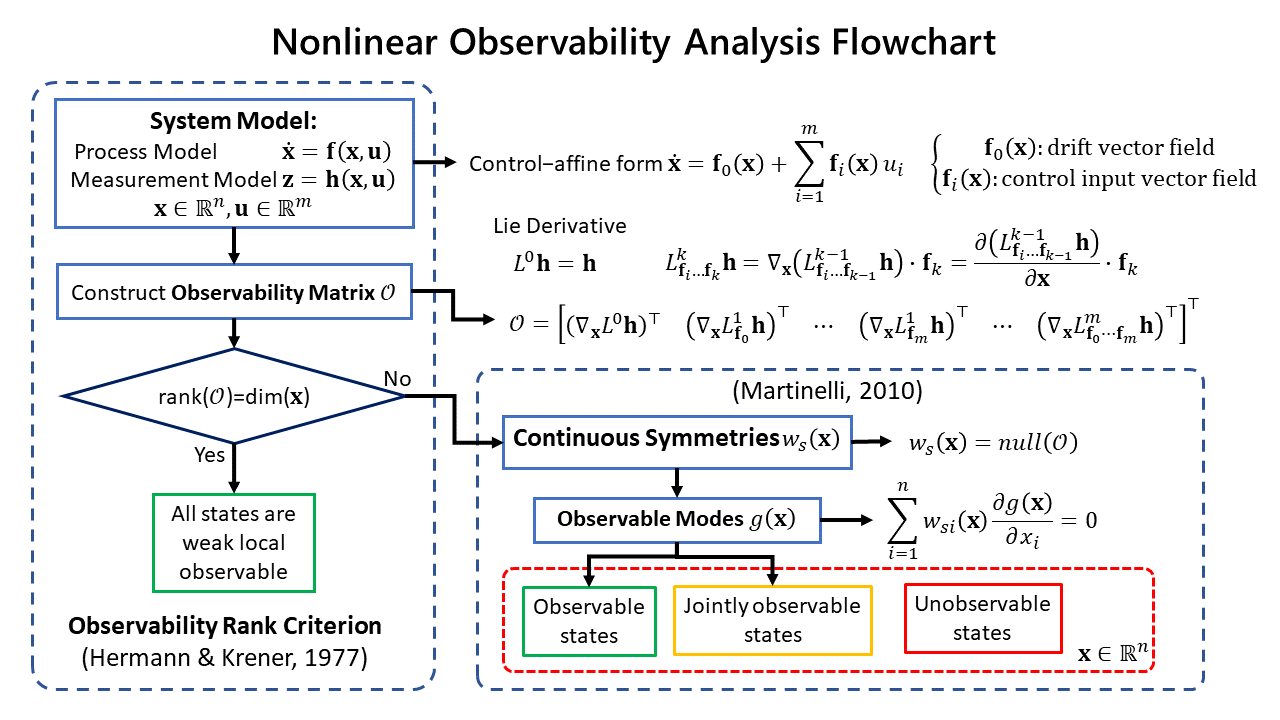PyNOA is a Python package for conducting the nonlinear observability analysis (NOA) of nonlinear control systems.
It is based on the concept of the observability rank criterion (ORC) by Hermann & Krener and the continuous symmetries by Martinelli.
The observability analysis gives an insight on
how well the states of a system can be inferred given its process model and measurement model.
Basically, if the system is observable, then an observer such as the Kalman filter can be implemented to estimate its states with estimation results that converge to the ground truth.
For a nonlinear system, the observability becomes a local property which brings up the concept of the weak local observability and the observability rank criterion (ORC) by Hermann & Krener. A system is weak local observable if its observability matrix is full rank. From this point on, we refer to the weak local observable as just observable.
However, in the case the system is not observable, the ORC does not give any information on which states are observable and which are unobservable. To solve this problem, the concept of continuous symmetries by Martinelli enables us to identify the observable, jointly observable, and unobservable states of a system as shown in the flowchart below.
- Observable state: an observable mode which consists of an individual state.
The estimation of this state will converge to the ground truth. - Jointly observable states: an observable mode which consists of a linear combination of states.
Some states in the joint observable subspace can be made observable provided that some other states' values in the joint observable subspace are already known.
(TODO: How to figure out which states' values should be known.) - Unobservable state: a state which is not included in the observable modes.
The estimation of this state will NOT converge to the ground truth, no matter how accurate the model's parameter values.
git clone https://github.com/BagaskaraPutra/PyNOA
cd PyNOA
pip3 install .-
Define the symbolic variables using
sp.symbols().
Initialize the NOA object usingobject = NOA("object_name"), then define the state vectors insp.Matrix([]).
Example:# State vector D, phi_R, theta_R = sp.symbols("D, phi_R, theta_R") mobile_robot = NOA("mobile_robot_symbolic") mobile_robot.x = sp.Matrix([D, phi_R, theta_R])
-
Define the vector fields
$f_0, f_1, ..., f_m$ of the control-affine form
$\mathbf{\dot x} = f_0(\mathbf{x}) + \Sigma_{i=1}^m f_i(\mathbf{x})u_i$
from the process model function$\mathbf{\dot x} = f(\mathbf{x},\mathbf{u})$ .
Vector fields that do not contain control inputs$u_i$ are defined in$f_0$ .
Vector fields that are linear to the control inputs$u_i$ are defined in$f_i$ .
Example:# Control-affine vector fields of process model \dot{x} = f(x,u) f0 = sp.zeros(3,1) f1 = sp.Matrix([[sp.cos(theta_R-phi_R), sp.sin(theta_R-phi_R)/D, 0]]).T f2 = sp.Matrix([[0,0,1]]).T mobile_robot.f = [f0, f1, f2]
-
Define the measurement model
Example:mobile_robot.h = sp.Matrix([sp.pi - theta_R + phi_R])
-
Choose how to construct the observability matrix.
Parameters:-
LD_order
The$k^{th}$ order of the Lie derivative. You can set this with positive integers$> 1$ (greater than one). -
combn_permn_opt
The arrangement of the Lie derivative vector fields from the$0^{th}$ order until the$k^{th}$ order-
"permutation": permutation of Lie derivatives. -
"combination": combination of Lie derivatives -
"drift2ndOrder: combination of Lie derivatives only until the$2^{nd}$ order, but the$2^{nd}$ order only has combinations between the drift vector field and control input vector fields${f}_0{f}_i$
-
Example:
mobile_robot.LD_order = 2 mobile_robot.combn_permn_opt = "combination"
will calculate the:
-
$0^{th}$ order Lie derivative:$L^0{h} = {h}$ -
$1^{st}$ order Lie derivatives:
$L^1_{f_0}h = \nabla_{\mathbf{x}} (L^0 h) \cdot f_0$
$L^1_{f_1}h = \nabla_{\mathbf{x}} (L^0 h) \cdot f_1$
$L^1_{f_2}h = \nabla_{\mathbf{x}} (L^0 h) \cdot f_2$ -
$2^{nd}$ order Lie derivatives
$L^2_{f_0 f_1} h = \nabla_{\mathbf{x}} (L^1_{f_0}h)\cdot f_1$
$L^2_{f_0 f_2} h = \nabla_{\mathbf{x}} (L^1_{f_0}h)\cdot f_2$
$L^2_{f_1 f_2} h = \nabla_{\mathbf{x}} (L^1_{f_1}h)\cdot f_2$
-
-
Choose the rank calculation option using
rank_calc_opt
Options:-
"symbolic": Calculate the rank of the observability matrix symbolically. -
"numeric": Calculate the rank of the observability matrix numerically by substituting the states, parameters, and inputs with numerical values.
[WARNING!] Ideally, you would want to use the"symbolic"option. Unfortunately,sympy'ssymboliccalculation may take a long time to complete, in some cases as long as a couple of hours. It is recommended to use thenumericoption for a system with more than 3 states.
-
-
Define which symbolic variables to substitute with random prime numbers in
params_config_subs = sp.Matrix([]).
[WARNING!] Make sure that all symbolic variables in the observability matrix are stated inparams_config_subs. If there are remaining symbolic variables in the observability matrix but not stated inparams_config_subs, it will remain symbolic and may increase computation time.-
Example 1:
This will substitute random prime numbers intomobile_robot_num.xin the observability matrix.
mobile_robot_num.params_config_subs = sp.Matrix([mobile_robot_num.x])
-
Example 2:
This will substitute random prime numbers into[x_T, x_G, x_I, u]in the observability matrix.
imu_baro.params_config_subs = sp.Matrix([x_T, x_G, x_I, u])
-
Example 3:
This will substitute random prime numbers into[x_T, x_G]. However, the variables[x_I, u]in the observability matrix remains symbolic.
imu_baro.params_config_subs = sp.Matrix([x_T, x_G])
-
Example 1:
-
Choose the nullspace calculation option using
null_calc_opt
Options:-
"symbolic": Calculate the nullspace of the observability matrix symbolically. -
"numeric": Calculate the nullspace of the observability matrix numerically by substituting the states, parameters, and inputs with numerical values.
-
-
martinelli_2010_simple_localization_mobileRobot2D.ipynb
-
martinelli_2010_odometry_calibration_mobileRobot2D.ipynb
Agostino Martinelli. "Continuous Symmetries and Observability Properties in Autonomous Navigation." [Research Report] RR-7049, INRIA. 2010.
-
ko_2019_quadrotor_inertialNavigation.ipynb
N. Y. Ko, I. H. Choi, G. Song and W. Youn, "Three-Dimensional Dynamic-Model-Aided Navigation of Multirotor Unmanned Aerial Vehicles," in IEEE Access, vol. 7, pp. 170715-170732, 2019, doi: 10.1109/ACCESS.2019.2955756.
